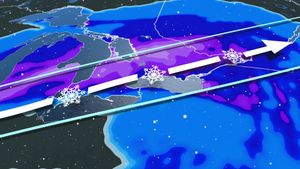The international scientific community is on high alert as asteroid 2024 YR4 presents the possibility of impacting Earth on December 22, 2032, with estimates indicating about a 2% chance. Discovered on December 27, 2024, by the Asteroid Terrestrial-impact Last Alert System (ATLAS) from Chile, the asteroid's risk level has evolved significantly as astronomers gather more observations.
According to NASA, the size of 2024 YR4 is estimated to be between 40 and 90 meters (130 to 300 feet) wide. This size classifies it as potentially hazardous, capable of causing regional damage if it were to strike Earth. On impact, the asteroid could release energy equivalent to around 8 megatons of TNT, significantly higher than the bomb dropped on Hiroshima. Julia de León, an astronomer at the Instituto de Astrofísica de Canarias, notes, "A similar-sized impact could destroy a city the size of Kansas City."
The asteroid is currently moving away from Earth, making it more challenging to track its path as the days pass. Observations with ground-based telescopes have become increasingly difficult, limiting effective tracking to instruments with diameters of four meters or more. By April, only the largest observatories will be able to detect it, necessitating the James Webb Space Telescope's intervention for continued scrutiny. This space telescope will first observe 2024 YR4 when it is at its brightest, with pivotal observations scheduled for March and May.
Juan Luis Cano of the European Space Agency (ESA) highlights the importance of time-sensitive research, stating, "It is very possible the probability of impact will still increase... before it falls to zero, because Earth will have been outside the zone of uncertainty." Calculations so far have shown fluctuations, with impact probabilities rising to 2.3% before settling back to 2.1% recently. Experts stress the need for more data to refine these predictions and potentially eliminate the risk altogether.
The asteroid’s orbit is influenced by gravitational pulls from other celestial bodies. Consequently, the likelihood of future encounters could change, especially after its next close pass to Earth scheduled for 2028. If scientists can rule out the potential for impact this time, they expect the possibility of such encounters will significantly decrease.
Historically, other asteroids have experienced similar trajectories. The case of asteroid Apophis is illustrative—initially having about a 3% chance of impact, it was later ruled out entirely as more data came to light. This pattern instills some optimism among scientists monitoring 2024 YR4.
Plans are already underway should the unlikely scenario of impact materialize. If the asteroid were confirmed to be on course for collision, evacuation protocols would target areas around the predicted impact zone, which includes parts of eastern Pacific Ocean and northern South America, as well as southern Asia. The expected impact could cause significant destruction, similar to the Tunguska event of 1908, which devastated 770 square miles of forest, thanks to a smaller meteor's explosion.
This potential threat has drawn the attention of the United Nations’ planetary defense agencies. The International Asteroid Warning Network and the Space Mission Advisory Group are collaborating to assess the situation and propose response options. Although they have begun preliminary discussions, they assert, "It is premature to develop specific recommendations for space missions."
Options for deflection include launching probes either to collide with the asteroid or employing nuclear technology to change its course. Paolo Martino of the ESA cautions about the technical hurdles of such missions, emphasizing the need for exhaustive study to predict the asteroid's orbit accurately.
While the situation is serious, experts urge the public not to panic. Teddy Kareta, of Lowell Observatory, reassures, "There’s a very, very small chance it hits the Earth at all... Even distant chances can seem alarming when communicated without sufficient data."
NASA and ESA are committed to providing regular updates as more information becomes available. The analysis of 2024 YR4 is handled through real-time assessments, with the international community closely tracking developments.
Should the asteroid be on track for impact, both space agencies are prepared to issue warnings and potentially initiate evacuation protocols, giving humanity the time to react effectively. Astronomers continue working diligently to gather as much data as possible during the window of observation before the asteroid eludes Earth’s view until it can be monitored again post-2028.
Through dedicated efforts with tools like the James Webb Space Telescope, scientists hope to clarify the risks posed by asteroid 2024 YR4. While the latest assessments suggest odds favoring safety, vigilance remains key. With this proactive approach, the global space community aims to safeguard our planet from any unforeseen cosmic impacts.



